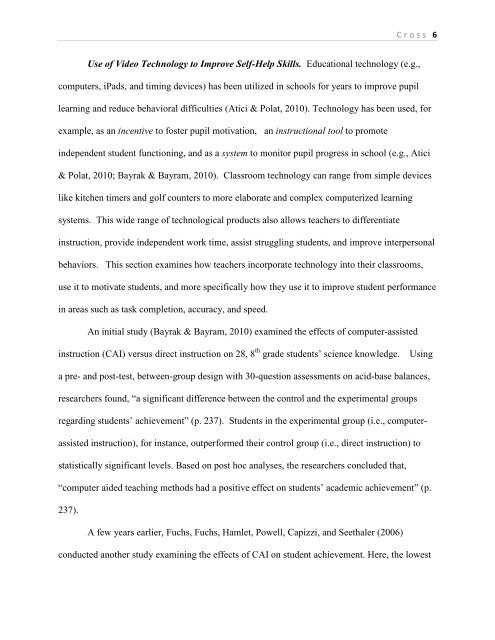THE EFFECTS OF A TIMER AND MYSTERY MOTIVATORS ON THE ...
THE EFFECTS OF A TIMER AND MYSTERY MOTIVATORS ON THE ...
THE EFFECTS OF A TIMER AND MYSTERY MOTIVATORS ON THE ...
Create successful ePaper yourself
Turn your PDF publications into a flip-book with our unique Google optimized e-Paper software.
C r o s s 6<br />
Use of Video Technology to Improve Self-Help Skills. Educational technology (e.g.,<br />
computers, iPads, and timing devices) has been utilized in schools for years to improve pupil<br />
learning and reduce behavioral difficulties (Atici & Polat, 2010). Technology has been used, for<br />
example, as an incentive to foster pupil motivation, an instructional tool to promote<br />
independent student functioning, and as a system to monitor pupil progress in school (e.g., Atici<br />
& Polat, 2010; Bayrak & Bayram, 2010). Classroom technology can range from simple devices<br />
like kitchen timers and golf counters to more elaborate and complex computerized learning<br />
systems. This wide range of technological products also allows teachers to differentiate<br />
instruction, provide independent work time, assist struggling students, and improve interpersonal<br />
behaviors. This section examines how teachers incorporate technology into their classrooms,<br />
use it to motivate students, and more specifically how they use it to improve student performance<br />
in areas such as task completion, accuracy, and speed.<br />
An initial study (Bayrak & Bayram, 2010) examined the effects of computer-assisted<br />
instruction (CAI) versus direct instruction on 28, 8 th grade students’ science knowledge. Using<br />
a pre- and post-test, between-group design with 30-question assessments on acid-base balances,<br />
researchers found, “a significant difference between the control and the experimental groups<br />
regarding students’ achievement” (p. 237). Students in the experimental group (i.e., computerassisted<br />
instruction), for instance, outperformed their control group (i.e., direct instruction) to<br />
statistically significant levels. Based on post hoc analyses, the researchers concluded that,<br />
“computer aided teaching methods had a positive effect on students’ academic achievement” (p.<br />
237).<br />
A few years earlier, Fuchs, Fuchs, Hamlet, Powell, Capizzi, and Seethaler (2006)<br />
conducted another study examining the effects of CAI on student achievement. Here, the lowest
















